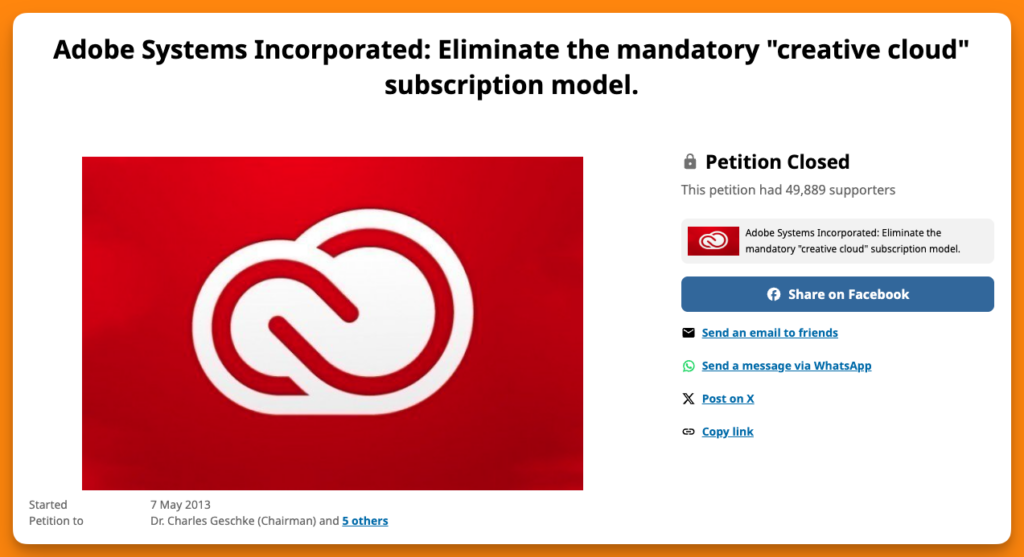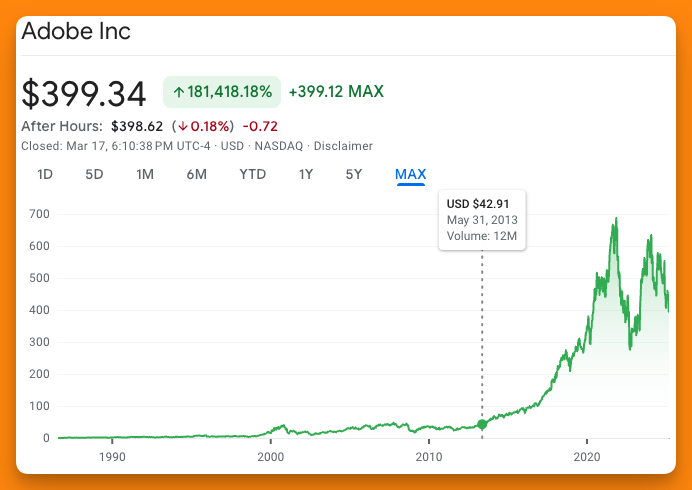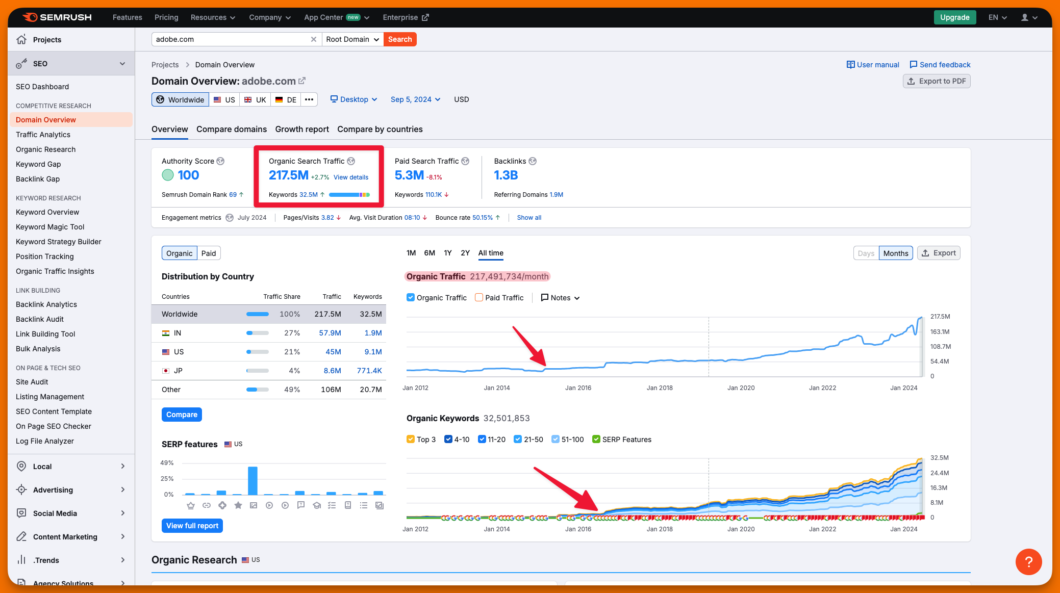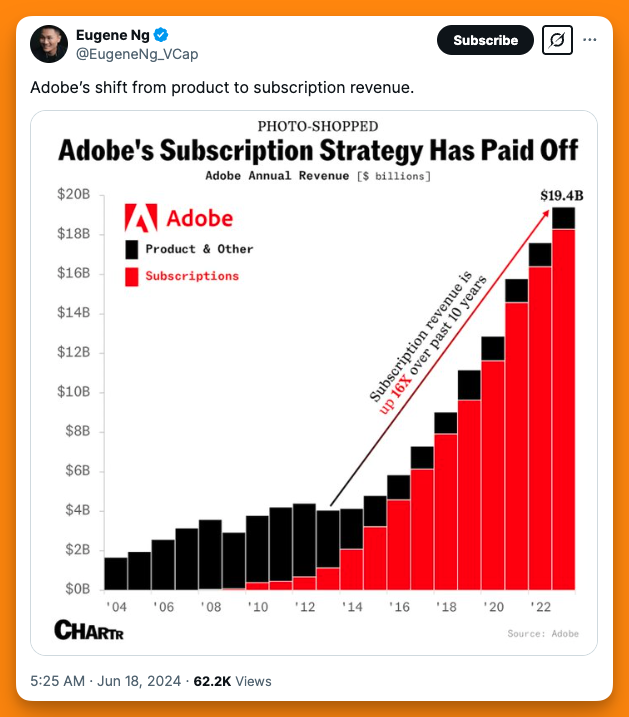“SEO is dead.” If this question bothers you, this post is for you.
Adobe is a household name in the creative software industry, known for popular applications like Photoshop, Illustrator, and Premiere Pro.
What’s more interesting is that this industry giant faced challenges in attracting organic search traffic, especially for non-branded keywords. Does this sound similar?
The biggest problem Adobe was able to solve was ranking for non-branded keywords, playing the brand awareness game, and then the conversion game.
In this case study, we’ll explore how Adobe overcame its SEO hurdles and doubled its organic traffic in 12 months by implementing a comprehensive, marketing-led SEO strategy.
Key Takeaways
Adobe’s SEO success story offers valuable insights for businesses looking to improve their organic search performance:
- Create dedicated pages for products and features: Develop individual, keyword-optimized pages for each product or feature to improve search visibility and user experience.
- Address technical SEO issues: Regularly audit and fix technical issues such as broken links, missing metadata, and duplicate content to ensure search engines can efficiently crawl and index your site.
- Invest in high-quality, SEO-optimized content: Consistently publish informative, engaging content that targets relevant keywords and incorporates expert insights to demonstrate authority and expertise.
- Monitor and minimize traffic cannibalization: Ensure regional sites are optimized for local keywords to prevent them from cannibalizing traffic from the main site.
- Leverage SEO tools and platforms: Utilize tools like Adobe Experience Manager, Google Analytics, and BrightEdge to identify opportunities, track performance, and gather competitive insights.
Adobe In Early Days
In 1982, two Xerox employees, John Warnock and Charles Geschke, pitched an idea to their superiors. It was Postscript, a programming language for managing the printing of documents on laser printers. At the time, dot matrix printers were widely used.
Xerox rejected the idea of PostScript, and both John and Charles quit Xerox to start their own venture, Adobe. PostScript was their first product, which was an instant hit.
In 1984, Adobe merged with Aldus, its biggest competitor at the time. Aldus had two products: Page Maker and After Effects. Adobe renamed Page Maker InDesign, while After Effects remained the same.
In 1995, Adobe acquired Photoshop for a whopping $34.5 million, making this one of the company’s most important acquisitions ever.
Again, in 2005, Adobe acquired Macromedia for $3.4 billion and merged Flash and Dreamweaver into its designer software suite.
After all these acquisitions, Adobe had a problem to solve. They wanted to move from one-time licenses to monthly subscriptions. In 2011, Adobe implemented this change, which didn’t go well with the existing customers.
So much so that a petition was filed against Adobe to eliminate this subscription model, and nearly 50,000 people signed the petition.

It took Adobe 4 years to adjust to this change and make peace with unhappy customers, but this move was a game-changer for the company.

The stock price soon after the pricing model change was around $42.91; today, it’s 10x the price.
The company’s revenue growth after the change in pricing has significantly impacted the account books.
16x growth in 10 years is mind-blowing 🤯
Here is the list of acquisitions made by Adobe to reach where it is right now.
Adobe CEO Shantanu Narayen was adamant about this change. He was able to foresee what most couldn’t at that time.
The change wouldn’t have had a positive impact if the execution after the change wasn’t near perfect.
Adobe began experimenting with subscriptions in 2011 with the Creative Cloud preview and fully committed by May 2013, replacing Creative Suite perpetual licenses with a subscription-only model (e.g., $49.99/month for the full suite).
This was a significant shift for the creative software industry, moving from one-time purchases (often $1,000+) to recurring revenue. However, Adobe was building on an established SaaS trend:
- Predecessors in Creative Space: While Adobe was among the first major players in creative software to go subscription-only, smaller SaaS-like models existed earlier. For example, companies like FreshBooks (launched in 2003) offered subscription-based invoicing tools with some creative overlap, though not on Adobe’s scale.
- Industry Trend: By 2011, SaaS was mainstream, with companies like Dropbox (2007, freemium with paid subscriptions) and Microsoft (Office 365, launched 2011) already in the game. Microsoft’s Office 365 rolled out its subscription model months before Creative Cloud’s full debut, though Adobe’s transition was more decisive in phasing out perpetual licenses.
Why Adobe Stands Out?
Adobe wasn’t the first SaaS adopter, but its 2013 move transformed its sector. Unlike Salesforce or NetSuite, which started as SaaS natives, Adobe converted a legacy perpetual-license business into a subscription giant, risking alienating its user base (e.g., the 50,000-signature petition).
Its success—revenue growing from $4 billion in 2013 to $19.41 billion in 2024—helped legitimize SaaS for consumer-facing creative tools, influencing others like Autodesk (2016 shift to subscriptions).
This case study is the story of what happened next.
The story of scaling subscription revenue with organic traffic.
You can learn from this case study and apply what worked for your products/services to dominate your niche. This is especially true for those slowly killing their startups with LTDs, thinking something is better than nothing.
The Challenge: Low Organic Traffic for Non-Branded Keywords
Despite being a well-known brand, Adobe struggled to attract organic search traffic for non-branded keywords related to its products and features.
Some of the critical issues Adobe faced included:
- Lack of dedicated pages for products and features: Adobe’s website had a single page showcasing all of its features (more than 30), resulting in poor user experience and difficulty for search engines to understand the page’s theme.
- Ranking only for branded keywords: Adobe’s products would rank well for branded terms like “Adobe Photoshop” but not for relevant non-branded keywords such as “image editing software” or “video editing software.”
- Technical SEO issues at scale: Adobe’s large, frequently changing website, managed by multiple regional teams, faced numerous technical SEO problems, such as broken links, missing redirects, and duplicate content.
- Traffic cannibalization: Regional sites were cannibalizing traffic from the main Adobe site, leading to poor user experience and inaccurate reporting.
These challenges prevented Adobe from reaching its full potential in organic search and attracting new customers who might not be familiar with the brand.
The Strategy: A Multi-Core Approach to SEO
To address these challenges, Adobe’s Senior Global SEO Manager, Kirill Kronrod, devised a comprehensive SEO strategy focusing on on-page optimization and technical improvements.
The key components of this strategy included:
1. Creating Individual Product and Feature Pages
One of the main issues hindering Adobe’s SEO performance was the lack of dedicated pages for its numerous products and features. To resolve this, they implemented the following:
- Pilot project: Created 15 individual pages for 15 features, each targeting a specific non-branded keyword identified through analytics, Google Webmaster Tools, and the BrightEdge SEO platform.
- Full rollout: After seeing an 8% increase in organic traffic and improved conversions from the pilot pages, Adobe created individual pages for all remaining product features.
With this in-depth, keyword-optimized content for each feature, Adobe made it easier for search engines to understand and rank these pages for relevant queries.
2. Fixing Technical SEO Issues
Adobe recognized the importance of addressing technical SEO issues to ensure that search engines could efficiently crawl and index their site. Some of the key actions taken included:
- Identifying and resolving issues: Using tools like Adobe Experience Manager’s SEO health checks, they identified and fixed problems such as broken links, missing metadata, and duplicate content.
- Implementing structured data: Adobe added structured data markup to their pages, making it easier for search engines to understand and display their content in rich results.
- Reducing traffic cannibalization: By improving their regional sites’ SEO and ensuring they ranked for relevant local keywords, Adobe minimized the issue of the leading site cannibalizing traffic from these properties.
3. Investing in High-Quality, SEO-Optimized Content
In addition to on-page optimization, Adobe created valuable, engaging content that targeted relevant keywords and satisfied user intent. This involved:
- Keyword research: Identifying non-branded keywords with high search volume and relevance to Adobe’s products and features.
- Informative content: Developing helpful, SEO-optimized articles and tutorials on topics related to design, photography, and video editing, targeting beginner-level keywords.
- Expert insights: Incorporating quotes and advice from subject matter experts, such as professional photographers and designers, to add depth and credibility to their content.
Publishing high-quality, keyword-rich content, Adobe demonstrated its expertise and authority in the creative industry, ultimately improving its search rankings and organic traffic.
The Results: Doubled Organic Traffic and Increased Market Share
Adobe’s comprehensive SEO strategy yielded impressive results within 12 months:
- 88% increase in organic traffic: Adobe saw an 88% increase in organic traffic to its Creative Cloud SEO content pages within the first six months.
- Doubled organic traffic: Adobe doubled its organic traffic in 12 months.
- 63% of non-branded traffic from feature pages: 63% of all non-branded organic traffic was attributed to these pages after creating individual feature pages.
- 66% share of voice: Adobe captured a 66% share of voice for non-branded keywords, with its five leading competitors accounting for the remaining 34%.
- 139% increase in revenue: The optimized content pages drove a 139% increase in revenue through organic search.
These results demonstrate the effectiveness of Adobe’s marketing-led SEO approach, which focuses on creating valuable content, optimizing on-page elements, and addressing technical issues.
What can a growing SaaS startup learn from the success of SEO?
A growing SaaS startup can learn valuable lessons from the success stories of companies that have effectively leveraged SEO to drive growth and achieve their business goals.
SEO is a powerful digital marketing strategy that can help SaaS companies increase their online visibility, attract qualified leads, and ultimately grow their customer base.
The Importance of SEO for SaaS Companies
Before diving into the specific lessons, it’s essential to understand why SEO is crucial for SaaS companies. In today’s digital landscape, potential customers often turn to search engines like Google to find solutions to their problems or to research products and services.
Optimizing your website and content for relevant keywords can improve your SaaS’s search engine rankings and make it easier for your target audience to be discovered online.
SEO offers several key benefits for SaaS companies, including:
- Increased brand awareness: Higher search engine rankings can help SaaS companies gain more exposure and build trust with potential customers.
- Qualified lead generation: By targeting keywords that align with their ideal customer profile, SaaS companies can attract more qualified leads actively searching for solutions like theirs.
- Cost-effective customer acquisition: Compared to paid advertising, SEO can be a more cost-effective way to acquire new customers over the long term.
- Competitive advantage: SaaS companies can gain a significant advantage in their market by outranking their competitors in search results.
Now, let’s explore key lessons that growing SaaS startups can learn from Adobe’s SEO case study.
#1 Focus on Non-Branded Keywords
- Research and target non-branded keywords relevant to your product’s features and use cases.
- Adobe created dedicated pages optimized for non-branded terms like “background remover” and “photo editor” to rank for searches beyond their brand name.
#2 Create Dedicated Feature Pages
- Develop individual, keyword-optimized pages for each product feature to improve search visibility and user experience.
- Adobe saw a significant boost in organic traffic after creating standalone pages for key features of products like Photoshop.
#3 Invest in High-Quality, SEO-Optimized Content
- Consistently publish informative, engaging content targeting relevant keywords and satisfying user intent.
- Adobe developed helpful articles and tutorials on design and photography to demonstrate expertise and drive organic traffic.
#4 Fix Technical SEO Issues
- Audit and resolve technical problems, such as broken links, duplicate content, and site speed, regularly to ensure search engines can efficiently crawl and index your site.
- Adobe took a proactive approach to identify and prevent technical SEO issues.
#5 Utilize a Clear URL Structure
- Implement a uniform URL structure with relevant keywords to help search engines understand your site hierarchically.
- Adobe used a consistent /product/feature/ format for its feature page URLs.
#6 Target the Entire Marketing Funnel
- Create content that aligns with keywords for each marketing funnel stage, from informational to transactional.
- Adobe targeted queries across the customer journey, from general topics to specific product searches.
The overarching takeaway is that a comprehensive, marketing-led SEO strategy focused on quality content, on-page optimization, and technical best practices can drive significant organic traffic growth for SaaS companies.
Ready to start ranking for non-branded keywords?
Adobe’s SEO success story is a testament to the power of a well-executed, comprehensive SEO strategy. By solving technical issues, creating dedicated product and feature pages, and investing in high-quality content, Adobe doubled its organic traffic in just 12 months and captured a significant share of voice for non-branded keywords.
This case study demonstrates that even established brands must continuously optimize and adapt their SEO strategies to stay ahead in an ever-evolving digital landscape.
Adobe’s SEO case study is a great source for learning and implementing the key takeaways outlined above. Businesses can unlock the full potential of organic search and drive meaningful results for their organizations.


